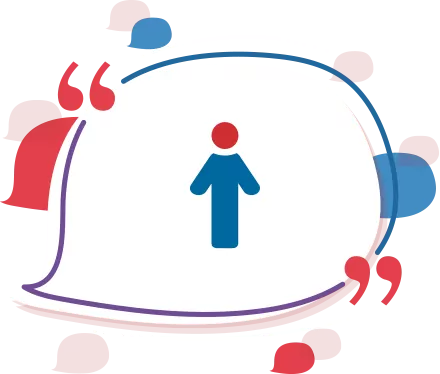En estos últimos días han presentado resultados la mayoría de las compañías clave.
Me gustaría hacer un breve resumen de las conferencias de TESLA, META, GOOGLE y AMAZON para aquellos que no hayan tenido tiempo de escucharlas o leerlas.
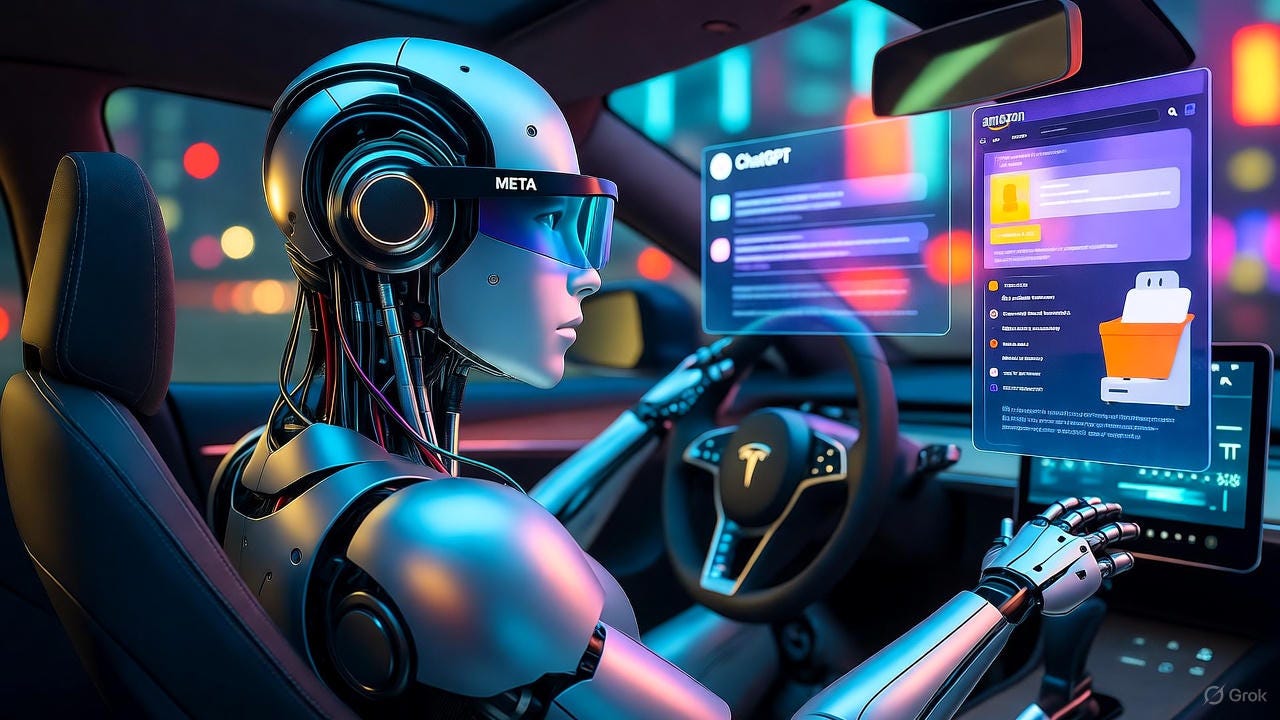
Quiero sintetizar en este post lo más relevante de cada una de ellas, de sus avances y de cómo el mundo está cambiando a velocidades que nunca antes habíamos imaginado.
Empezamos.
TESLA Q3 2025: “The real-world AI company”
Tesla dejó de ser solo una empresa de automoción.
En la conferencia del Q3 2025, Elon Musk redefinió la misión de la empresa: pasar de sustainable energy a sustainable abundance.
Es decir, usar la inteligencia artificial física (coches, robots, energía) para crear una economía sin escasez.
“We’re at a critical inflection point for Tesla… bringing AI into the real world.”
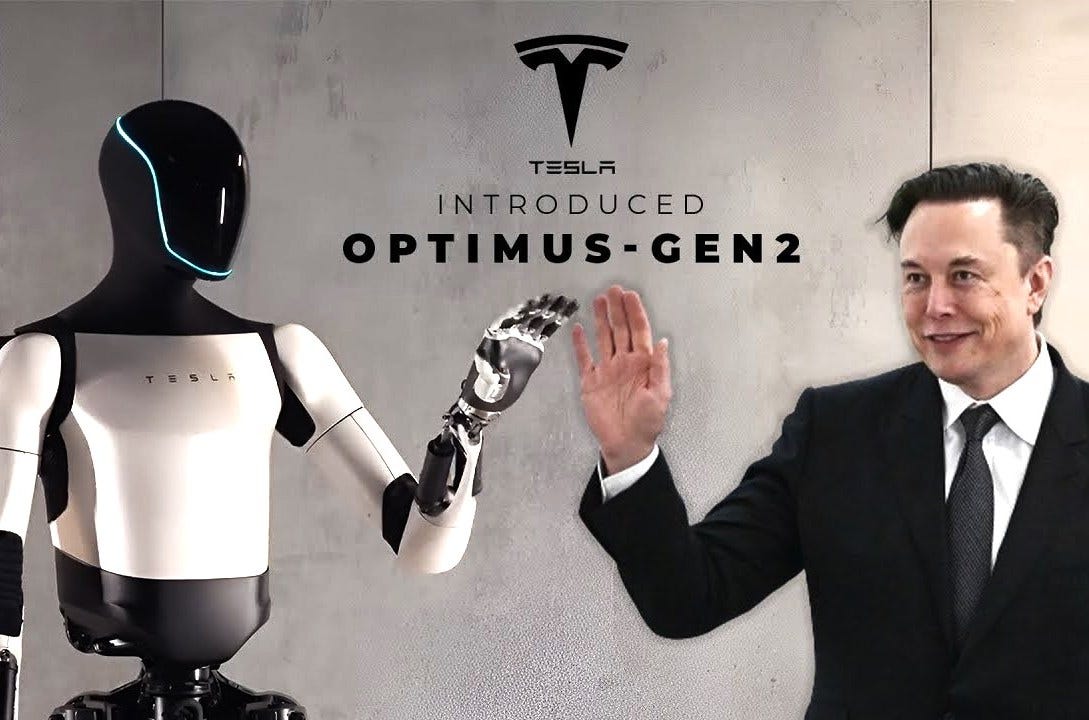
Full Self-Driving: el momento del “shock wave”
Musk declaró lo que muchos esperaban desde hace años, tiene “claridad” en haber alcanzado el full self-driving no supervisado.

A finales de 2025, Austin operará sin safety drivers, y se planean 8 a 10 nuevas ciudades (Nevada, Florida, Arizona…).
“We expect to have no safety drivers in Austin within a few months.”
“Honestly, it’s going to be like a shock wave.”
El software FSD v14 ya está disponible en EE. UU., y los usuarios han conducido más de 6.000 millones de millas con él.
El siguiente paso: añadir “reasoning”, capacidad de razonamiento, en las versiones 14.3 y 14.4, para que el coche literalmente piense dónde aparcar o cómo anticiparse al tráfico.

“This car will feel like it is a living creature.”
Robotaxi y la expansión del hardware
Tesla inicia una nueva categoría, el Cybercab, un vehículo sin volante ni pedales optimizado para conducción autónoma total.
Producción: Q2 2026. Capacidad objetivo: 3 millones de vehículos anuales en 24 meses.
Like here’s the killer app really, what it comes down to is can you text while you’re in the car? And if you tell someone, yes, the car is now so good, you can be on your phone and text the entire time while you’re in the car.
It’s anyone who can buy the car will buy the car and its end of story. So that’s what everybody wants to do. In fact, not everyone wants to do, they do, do that.
Optimus: el proyecto más ambicioso de Tesla
Musk lo definió sin rodeos:
“We’re also on the cusp of something really tremendous with Optimus, which I think is likely to be or has potential to be the biggest product of all time. And it’s a difficult project. And it’s worth noting that it’s not like it’s just automatic.
I’m not aware of any robot program by Ford or GM or any U.S. sort of car companies. People like, I think maybe think of Tesla as a car company, we mostly make cars and battery packs.”
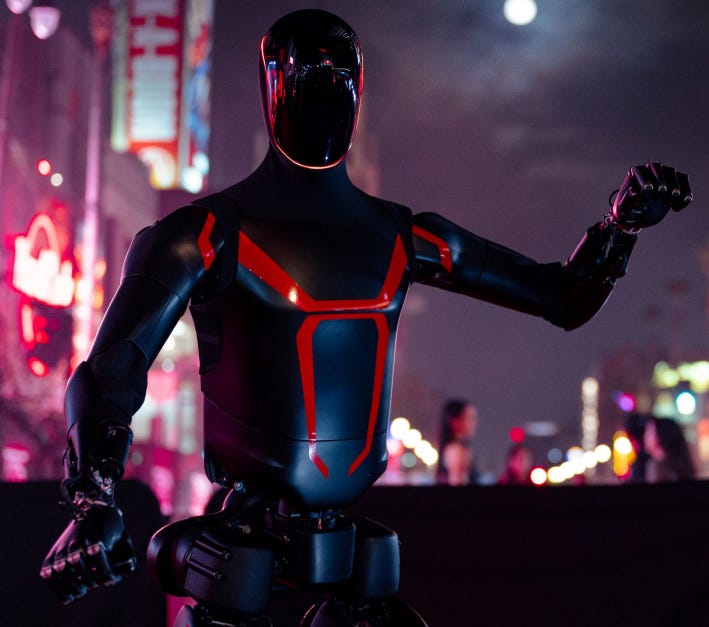
El robot humanoide ya camina, interactúa y trabaja en las oficinas de Palo Alto.
La versión 3 se presentará en Q1 2026 y será tan realista que, según Musk,
“But it will seem so real that you’ll need to like poke it, I think, to believe that it’s actually a robot. And obviously, like the real-world intelligence we’ve developed for the car, most of that transfers to Optimus. So it’s a very good starting point.”
El plan industrial es monumental: 1 millón de robots al año en su primera línea de producción y luego escalar hasta decenas de millones.
Su mayor reto técnico: crear una mano tan precisa como la humana.
“The Optimus hand and forearm is an incredibly difficult engineering challenge.
I’d say it’s more difficult than the rest of -- from an electromechanical standpoint, the forearm and hand is more difficult than the entire rest of the robot.”
El nuevo corazón de Tesla: AI5
El nuevo AI5 es 40 veces más potente que el AI4 y se fabricará en EE. UU. (Samsung Texas, TSMC Arizona).
Sin GPU tradicional, con diseño minimalista y enfoque total en rendimiento por vatio.
“I have spent almost every weekend for the last few months with the chip design team working on AI5.
And I don’t hand out praise easily, but I have to say that I think the Tesla chip team is really designing an incredible chip here.
This is -- by some metrics, the AI5 chip will be 40x better than the AI4 chip, not 40%, 40x because we have a detailed understanding of the entire software and hardware stack. So we’re designing the hardware to address all of the pain points in software.”
Elon confiesa haber dedicado “every weekend for the last few months” al diseño del chip junto al equipo de ingeniería.
La visión es un exceso deliberado de chips que también nutrirán los futuros data centers de Tesla.
Energía: el negocio silencioso que ya lidera
Mientras el foco mediático está en FSD y Optimus, la división energética batió récords.
Revenues, margen y cash flow crecieron a doble dígito, con fuerte demanda de Megapack y Powerwall en un contexto de boom de IA y datacenters.
“So with both Powerwall and especially with the Megapack, we are dramatically improving the ability to generate more energy from the grid.
Let me sort of talk a little bit about that, which is if you look at total U.S. energy capability, for example, there’s roughly a terawatt of continuous power available in the U.S. But the average usage over a 24-hour cycle is only 0.5 terawatt because of the big difference between day and night usage.”
El lanzamiento del Megapack 4 (salida directa a 35 kV) y el Tesla Solar Panel en Buffalo consolidan a Tesla Energy como un negocio rentable, recurrente y en expansión global.
Finanzas sólidas, CapEx al alza
Tesla reportó free cash flow récord de $4.000 millones y caja total de $41.000 millones.
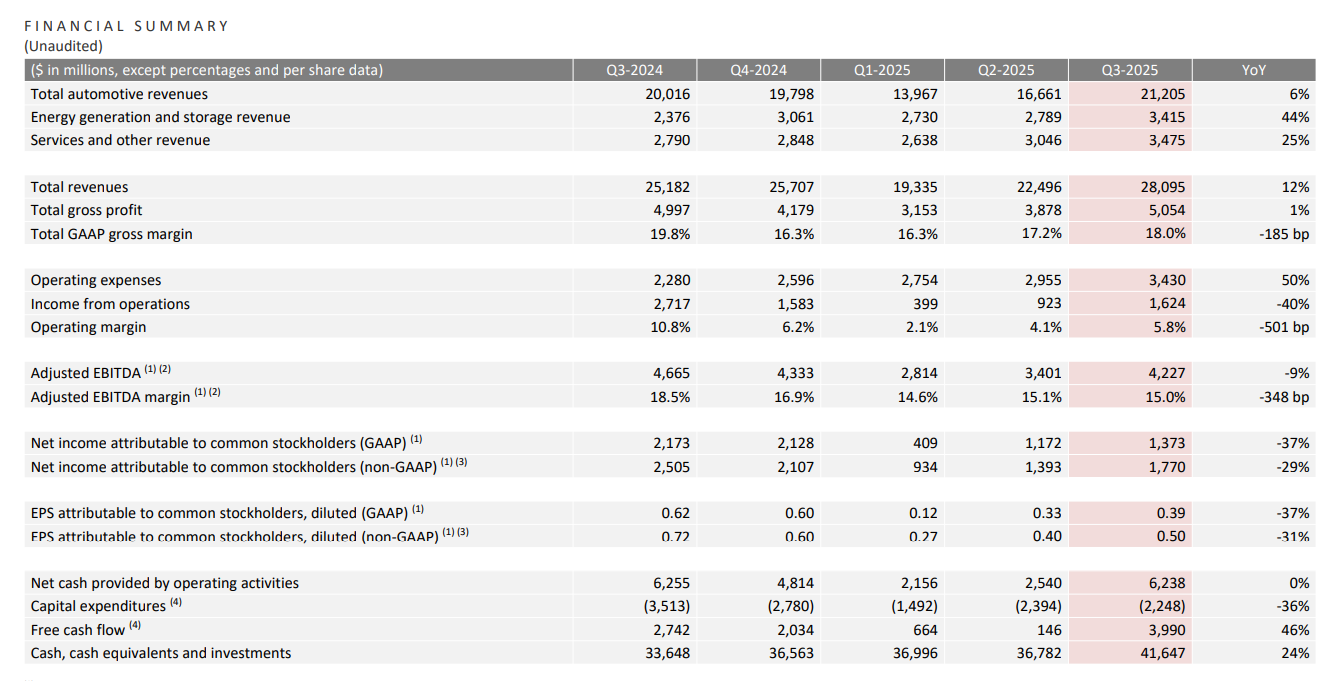
Las entregas crecieron en todas las regiones: China +33%, Norteamérica +28%, EMEA +25%.
CapEx 2025 rondará los $9.000M, pero 2026 será año de inversión fuerte en fábricas de IA y robots.
Gobernanza y control: la batalla interna
Elon Musk fue inusualmente frontal con su preocupación por el poder de los proxy advisors:
“ISS and Glass Lewis are corporate terrorists.”
Su prioridad no es dinero, sino mantener influencia sobre el futuro “ejército de robots” de Tesla.
“Like I don’t feel comfortable building that robot army if I don’t have at least a strong influence.”
El 6 de noviembre se votará su paquete de compensación y su nivel de control accionarial.
El desenlace definirá el grado de autonomía real que tendrá el fundador para ejecutar la próxima fase.
La frase que resume todo
“Optimus at scale is the infinite money glitch.”
Elon Musk ve en la robótica y la autonomía total no solo un salto tecnológico, sino una nueva era económica.
TSLA 2.13%↑ se está transformando de fabricante de coches eléctricos a plataforma global de inteligencia física, capaz de escalar hardware, software, energía y AI en un solo sistema.
En resumen
Tesla Q3 2025 no fue una call de resultados.
Fue la presentación informal del nuevo Tesla, una empresa que combina márgenes positivos, flujo de caja sólido y la ambición de colonizar el mundo físico con IA propia.
“So it’s plugged in the whole time. And what -- so that’s why I call it like if you’re true of sustainable abundance, where working will be optional.
There’s a limit to how much AI can do in terms of enhancing the productivity of humans, but there is not really a limit to AI that is embodied. ”
- Canal de Telegram: https://t.me/tusfinanzaspersonalesybolsa
- Canal de YouTube: https://www.youtube.com/@tusfinanzas_personales
- X (Twitter): https://x.com/Finanzasybolsa
- Instagram👉: tusfinanzaspersonales
Meta Q3 2025: “Building Personal Superintelligence for Everyone”
Mark Zuckerberg abrió la call con confianza total.
Dijo que “We had another strong quarter with 3.5 billion people using at least one of our apps every day”.

Instagram alcanzó 3.000 millones de usuarios activos mensuales, y Threads ya supera los 150 millones diarios, consolidándose como la red social con mayor crecimiento orgánico del planeta.
Pero el mensaje central no fue el crecimiento de usuarios. Fue la visión. Zuck lo resumió en una frase que marca época:
“I am very focused on establishing Meta as the leading frontier AI lab. Building personal superintelligence for everyone.”
Meta ya no se define por Facebook o Instagram, sino por su ambición de crear una inteligencia artificial personal a escala planetaria, abierta y distribuida. “Our approach of advancing open source AI means that when Meta innovates, everyone benefits”, explicó.
El músculo detrás de la visión
Zuck admitió que hay diferentes opiniones sobre cuándo llegará la superinteligencia, algunos creen que en pocos años, otros que tomará una década. Su respuesta fue directa:
“I think that it’s the right strategy to aggressively frontload building capacity so that way we’re prepared for the most optimistic cases.
That way, if superintelligence arrives sooner, we will be ideally positioned for a generational paradigm shift in many large opportunities.”
Meta está adelantando la inversión masiva en computación para estar lista “for the most optimistic cases”.
Si la superinteligencia llega antes de lo esperado, Meta quiere ser la empresa mejor posicionada para liderar el cambio de paradigma.
Más tiempo, más contenido, más rentabilidad
Las mejoras en recomendación impulsadas por IA están dando resultados visibles. Zuckerberg destacó que el tiempo en Facebook aumentó un 5% y en Threads un 10% solo en el trimestre.
“Video is a particular bright spot with video time spent on Instagram up more than 30% since last year.
And as video continues to grow across our apps, Reels now has an annual run rate of over $50 billion.”
Reels ya genera un run rate anual de más de 50.000 millones de dólares, y el algoritmo de recomendación unificado impulsa también la publicidad.
“Our completely end-to-end AI-powered ad tools has passed $60 billion in annual run rate.”
Meta está construyendo tres grandes sistemas de IA –uno para Facebook, otro para Instagram y otro para Ads– con el objetivo de fusionarlos en un único modelo unificado.

Meta AI y Vibes: el nuevo contenido nace de la IA
Más de 1.000 millones de personas usan Meta AI cada mes, y su adopción crece a medida que mejora el modelo Llama. Zuck adelantó que pronto integrarán “frontier models with novel capabilities” que no existen en otros lugares.
La herramienta Vibes, lanzada en septiembre, representa el nuevo tipo de contenido nacido de la IA.
“Retention is looking good so far. And its usage keeps growing quickly week over week. I’m looking forward to ramping up the growth of Vibes over the coming months.
More broadly, I think that Vibes is an example of a new content type enabled by AI, and I think that there are more opportunities to build many more novel types of content ahead as well.”
En pocas semanas, los usuarios generaron más de 20.000 millones de imágenes con las herramientas de IA de Meta.
Hardware inteligente: Meta Ray-Ban y Oakley Vanguards
Meta ya lidera en el segmento de AI glasses. Los nuevos Ray-Ban y Oakley Meta se agotaron en 48 horas.
“They sold out in almost every store within 48 hours with demo slots fully booked through the end of next month.”
Zuckerberg lo ve como la base de una nueva plataforma de computación. “This is an area where we are clearly leading and have a huge opportunity ahead.”
Los números detrás del relato
Susan Li confirmó que el trimestre fue excelente.
- Ingresos totales: 51.200 millones de dólares, un 26% más interanual.
- Ingresos por publicidad: 50.100 millones, también +26%.
- Beneficio operativo: 20.500 millones (margen del 40%).
- Free cash flow: 10.600 millones.
- Caja: 44.400 millones.

El crecimiento se debe a una mezcla de mayor engagement, aumento del precio medio por anuncio (+10%) y la adopción masiva de herramientas automatizadas.
La CFO destacó que “advertisers who run lead campaigns using Advantage+ are seeing a 14% lower cost per lead”, confirmando que la IA ya genera retornos tangibles.
Inversión récord y foco total en compute
Li confirmó que Meta invertirá entre 70 y 72 mil millones de dólares en CapEx en 2025, principalmente en centros de datos y servidores de IA. Pero lo más importante: 2026 será aún más agresivo.
“As we have begun to plan for next year, it’s become clear that our compute needs have continued to expand meaningfully, including versus our own expectations last quarter.
We are still working through our capacity plans for next year, but we expect to invest aggressively to meet these needs, both by building our own infrastructure and contracting with third-party cloud providers.”
El gasto en IA y Superintelligence Labs crece más rápido que cualquier otro segmento.
La plantilla aumentó un 8%, centrada en “monetization, infrastructure, Reality Labs and Meta Superintelligence Labs.”
Zuck lo dejó claro:
“So my view on this is that rather than continuing to be constrained on CapEx and feeling in the core business like we have significant investments that we could make that we’re not able to make that would be profitable.
But the right thing to do is to try to accelerate this to make sure that we have the compute that we need, both for the AI research and new things that we’re doing and to try to get to a different state on our compute stance on the core business. So that’s kind of how I’m thinking about that overall.”
Meta Superintelligence Labs: la nueva frontera
Zuckerberg repitió varias veces que está construyendo el laboratorio con “the highest talent density in the industry.”
Su objetivo es entrenar los modelos de siguiente generación y crear productos capaces de razonar y entender el mundo real.
“We know Meta has the best track record of any company in taking a new product people love and getting it to billions of people.”
Cómo Meta piensa monetizar la IA
Cuando le preguntaron por monetización, Zuckerberg fue transparente. Dijo que la prioridad ahora es escala y utilidad, no ingresos inmediatos:
“I think the most promising thing that we’re seeing is, one, that we were able to build something that a large number of people use, and I think that’s valuable.
And then secondly, that as we -- there is a clear correlation as we improve the models in ways that we think make them better, that people use them more.
So that shows that we have a runway to basically be able to improve engagement and turn this into a product that’s leading over time.”
A medio plazo, la IA se integrará en el ciclo completo de marketing:
“Advertisers will just give us a business objective and a credit card, and the AI will figure out everything else.”
Desde generar el video y la música del anuncio hasta decidir el público y el formato óptimo.
Wearables y la nueva plataforma de computación
Zuckerberg ve en los Ray-Ban y Oakley Meta el primer paso hacia una nueva forma de interactuar con la IA.
“Over time, the AI is going to become the main thing that people are using them for.”
El objetivo final es llegar a cientos de millones de usuarios y construir una base de hardware que permita experiencias de IA contextual.
En resumen
“We’re building personal superintelligence for everyone.”
“If we deliver even a fraction of the opportunity ahead, the next few years will be the most exciting in our history.”
Meta ya no compite por tiempo en pantalla. Compite por crear la inteligencia que el resto del mundo usará.
Alphabet Q3 2025: “AI is now deeply integrated across everything we do”
Sundar Pichai abrió la llamada con una afirmación que lo resume todo. “AI is now deeply integrated across everything we do.”
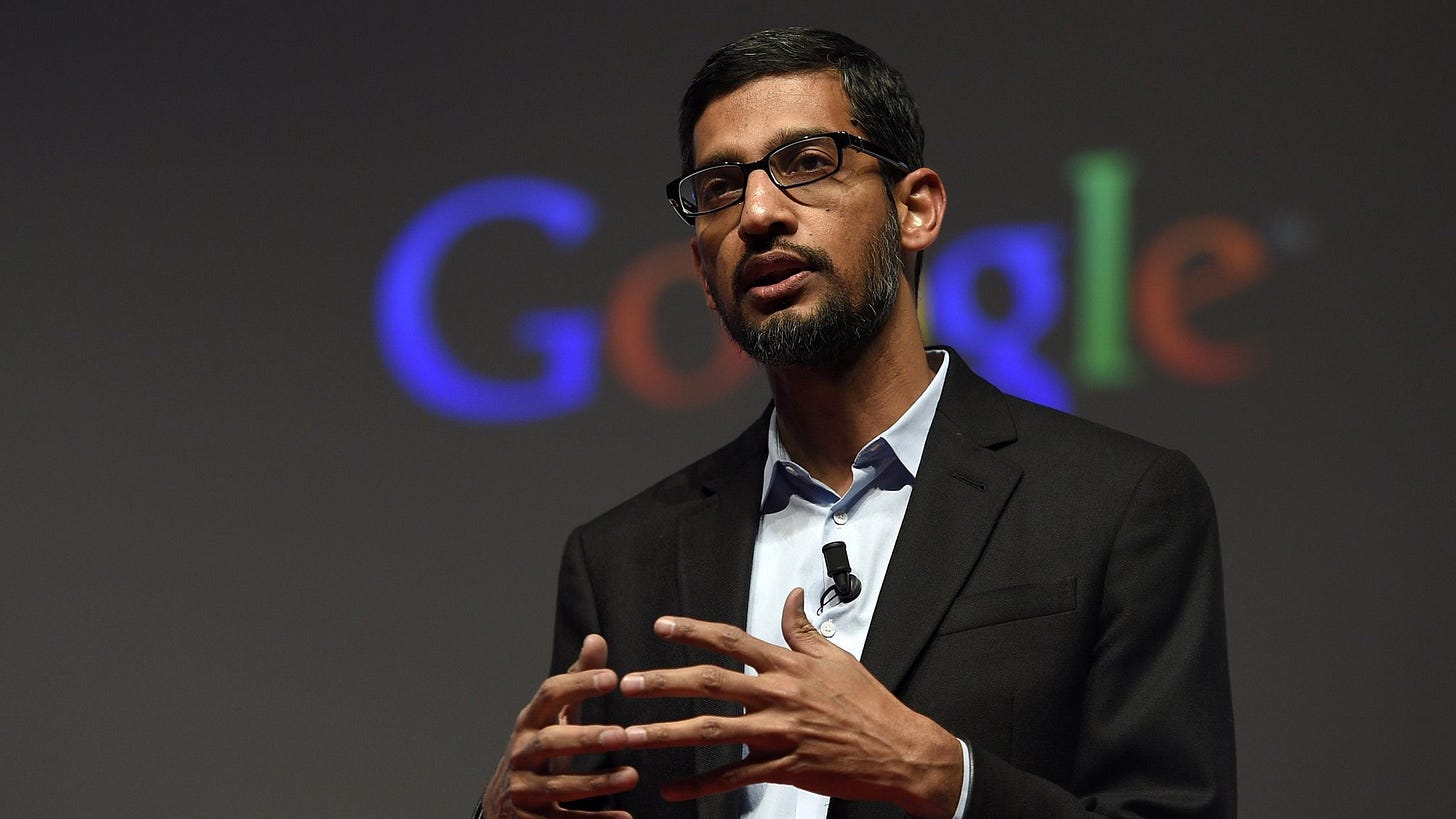
Con esa frase, dejó claro que Google ya no habla de “integrar IA en sus productos”, sino que su negocio entero está siendo reescrito por ella.
Alphabet tuvo otro trimestre sólido.
Los ingresos totales crecieron 16% hasta 102.3 mil millones de dólares, marcando su primer trimestre por encima de los 100 mil millones en ventas.
Pero la verdadera historia no está en los números. Está en cómo Google está transformando su infraestructura, su producto y su cultura alrededor de la inteligencia artificial generativa.
Gemini se consolida como el corazón del ecosistema
Pichai destacó que “Gemini is powering Search, Ads, Cloud, YouTube and Workspace”, describiendo una empresa unificada bajo un mismo modelo.
El despliegue de Gemini 2 en Search Labs y su integración con las respuestas generativas (SGE) ya muestra métricas prometedoras: los usuarios interactúan más, pasan más tiempo por sesión y hacen más consultas.
Sundar explicó que “we’re seeing encouraging growth in engagement and query satisfaction when users try generative experiences in Search.”
Google está convirtiendo su buscador en un asistente conversacional que genera respuestas, ideas y contenido, moviéndose más rápido de lo que el mercado anticipaba.
YouTube y los nuevos formatos de contenido
YouTube sigue siendo un motor de crecimiento. Philipp Schindler lo dijo sin rodeos:
“Shorts continues to be a bright spot with over 2 billion logged-in viewers each month.”
“Shorts continues to be a bright spot with over 2 billion logged-in viewers each month.”
El consumo de Shorts creció más del 20% interanual, impulsado por mejoras en las recomendaciones de IA. Pero lo más interesante es cómo YouTube está usando la IA para optimizar la monetización.
Schindler explicó que “AI-powered creative tools are helping advertisers generate multiple ad variations in minutes,” aumentando conversiones y reduciendo costes de producción.
Además, YouTube Ads alcanzó un run rate anual superior a 40.000 millones de dólares, beneficiándose de lo que Schindler llamó “a virtuous cycle of better creative, better engagement, better ROI.”
Google Cloud: resiliencia y márgenes en expansión
Cloud fue otro punto alto.
Los ingresos de Google Cloud crecieron 34% interanual hasta 15.2 mil millones de dólares, con una expansión de margen operativo hasta 23.7%, su tercer trimestre consecutivo de mejora.
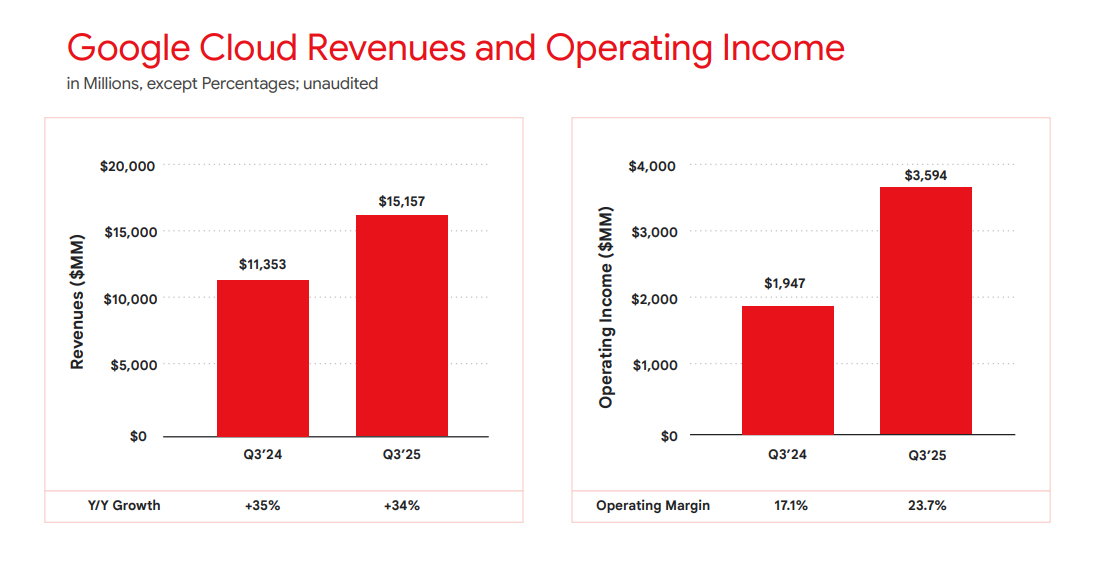
Pichai subrayó que “we’re seeing strong demand for AI infrastructure and Vertex AI adoption is accelerating among large enterprises.”
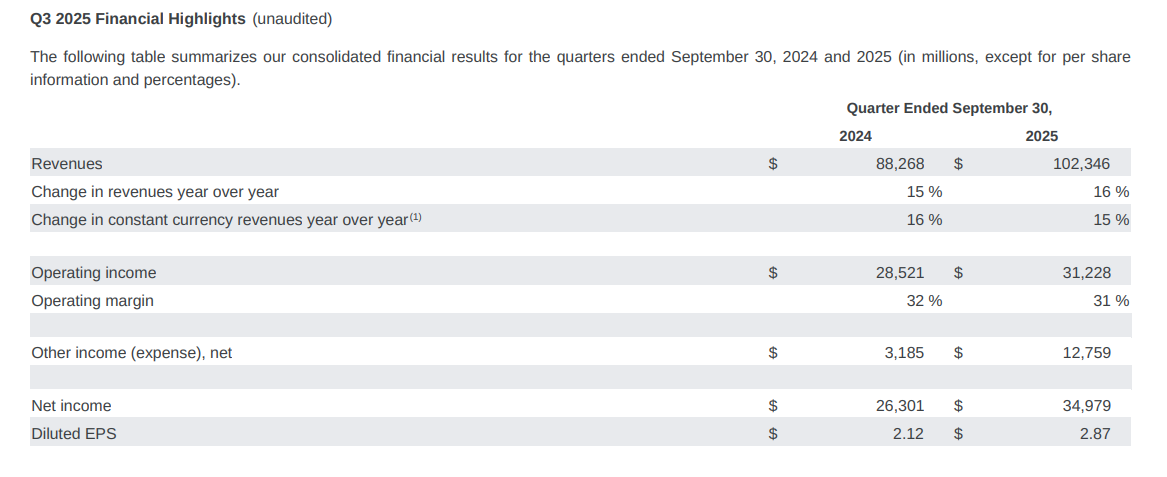
Más del 60% de las empresas del Fortune 500 ya están utilizando algún producto de Vertex o Gemini Cloud. Entre los ejemplos destacados, Sundar mencionó a Walmart, General Motors y JPMorgan, que están desarrollando copilots internos sobre infraestructura de Google.
El CEO fue claro: “Our AI infrastructure advantage is real. TPUs and our custom silicon are allowing customers to train and serve models at lower cost and higher efficiency.”
“I do think a big part of what differentiates Google Cloud, effectively, we have taken a deep full-stack approach to AI, so we are -- and that really plays out. We are the only hyperscaler who is really building offerings on our own models.”
Ruth Porat complementó que el negocio Cloud ya está contribuyendo positivamente al flujo de caja operativo y que “AI workloads now represent the majority of incremental demand for compute.”
CapEx: el nuevo centro de gravedad financiero
Ruth Porat, CFO y Presidenta de Alphabet, dedicó buena parte de su intervención a explicar la magnitud del gasto en infraestructura.
“With respect to CapEx in the third quarter, our CapEx was $24 billion. The vast majority of our CapEx was invested in technical infrastructure, with approximately 60% of that investment in servers and 40% in data center and networking equipment.”
La mayor parte se destinó a centros de datos y chips de inteligencia artificial, lo que Porat describió como “front-loading investments to stay ahead of demand for AI compute.”

Añadió que “we’re building for a decade of growth in AI.”
En otras palabras, Google está acelerando antes que el resto, preparándose para un ciclo de demanda estructural que apenas comienza.
Cuando se le preguntó si el gasto podría moderarse en 2026, Porat respondió con franqueza.
“We continue to see elevated CapEx in 2026 as we expand capacity globally. We are not in optimization mode, we are in build mode.”
Este mensaje fue recibido como una reafirmación del enfoque de largo plazo: gastar más hoy para dominar la próxima ola tecnológica.
Search y Ads: la vieja máquina, ahora con un nuevo cerebro
Pichai destacó que “Ads performance remains strong, with ongoing momentum in retail and travel,” y atribuyó gran parte del crecimiento a los nuevos sistemas basados en IA.
El uso de modelos generativos permite a los anunciantes crear automáticamente textos, imágenes y vídeos optimizados para cada segmento.
Philipp Schindler resumió la nueva era publicitaria con una frase simple:
“Looking at monetization, businesses can now tap into our most powerful AI search experiences.
Using our most advanced AI models, we can understand and predict intent like never before, unlocking entirely new commercial pathways to provide valuable new consumer connections and helping us monetize even more efficiently.”
Esa transición implica que la IA de Google no solo muestra anuncios relevantes, sino que predice la intención y el contexto del usuario con precisión milimétrica.
La apuesta cultural: AI-first, otra vez
Si en 2016 Sundar dijo que Google era una “AI-first company”, en 2025 ese lema cobra un nuevo significado.
El CEO explicó que los equipos de ingeniería están “rebuilding the company’s core systems around large models,” desde la indexación de la web hasta la seguridad en Android y Chrome.
Alphabet como plataforma de IA global
La compañía está posicionándose no solo como proveedor de herramientas, sino como plataforma universal de IA.
Pichai explicó que “our goal is to make Gemini and our models universally accessible through Google Cloud, Workspace and Android.”
Conclusión
El trimestre de Alphabet confirma que Google ha pasado del discurso a la ejecución.
Ya no se trata de experimentar con IA, Gemini es el sistema nervioso central de toda la empresa.
Como escribió uno de los analistas tras la call: “Alphabet no está reaccionando al cambio de paradigma. Lo está construyendo.”
Amazon Q3 2025: el trimestre que marca un nuevo ciclo de crecimiento
“AWS is growing at a pace we haven’t seen since 2022, reaccelerating to 20.2% year-over-year.” — Andy Jassy, CEO
Amazon presentó unos resultados de Q3 2025 que dejan una sensación inequívoca:
el ciclo de desaceleración post-pandemia ha terminado.
el ciclo de desaceleración post-pandemia ha terminado.
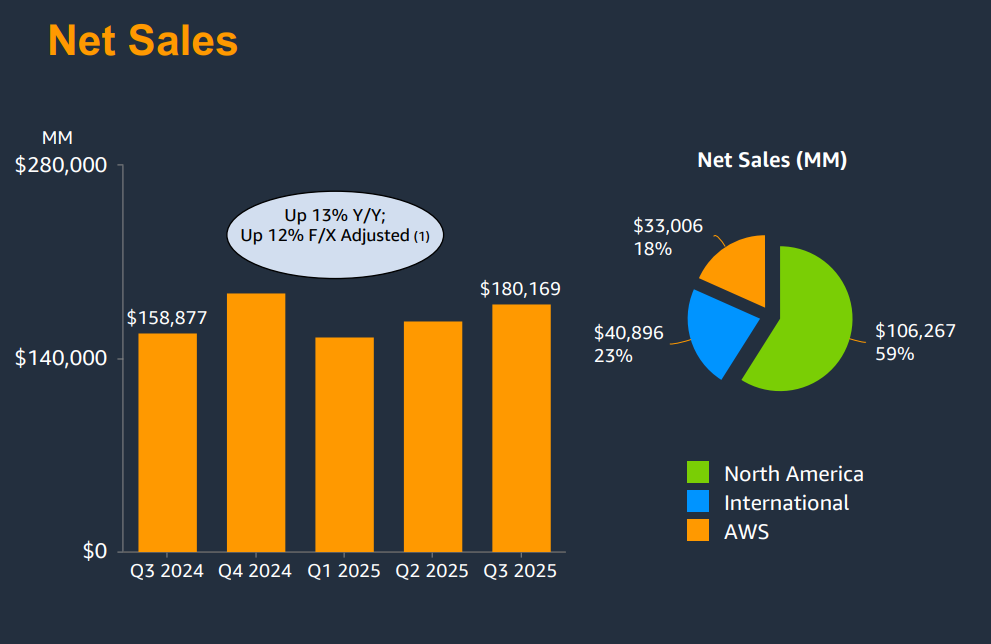
AWS acelera, el negocio de anuncios crece a doble dígito, y las tiendas físicas y de e-commerce se reinventan con inteligencia artificial.
- Ingresos totales: $180.2 B (+12% YoY)
- Operating income: $17.4 B (hubiera sido $21.7 B sin los cargos extraordinarios)
- Free cash flow (TTM): $14.8 B
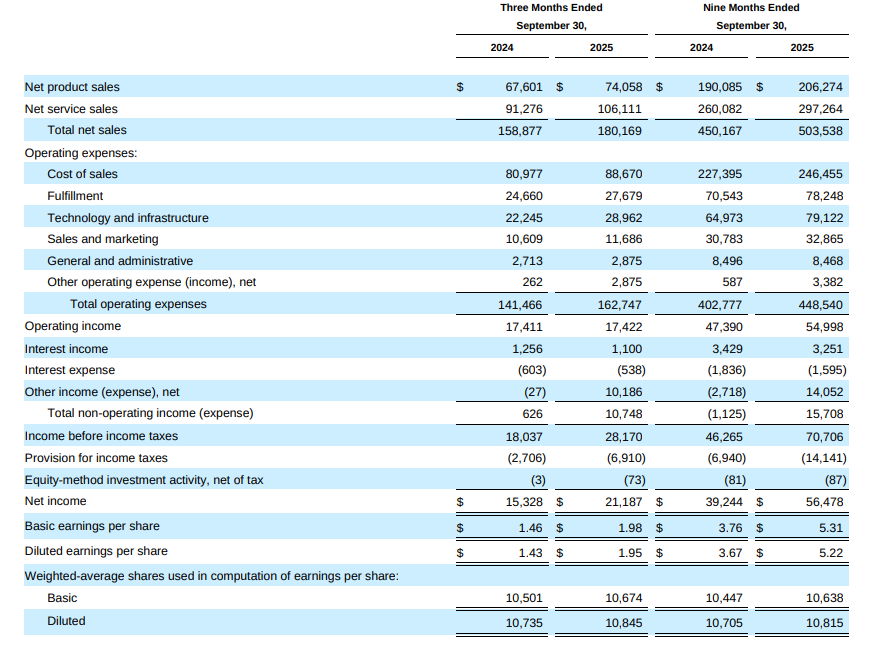
AWS: vuelve el crecimiento fuerte
“Backlog grew to $200 billion by Q3 quarter end… AWS is gaining momentum.” — Andy Jassy
AWS volvió a su nivel de crecimiento más alto en casi tres años:
+20.2% YoY, con un run rate anualizado de $132 B.
+20.2% YoY, con un run rate anualizado de $132 B.
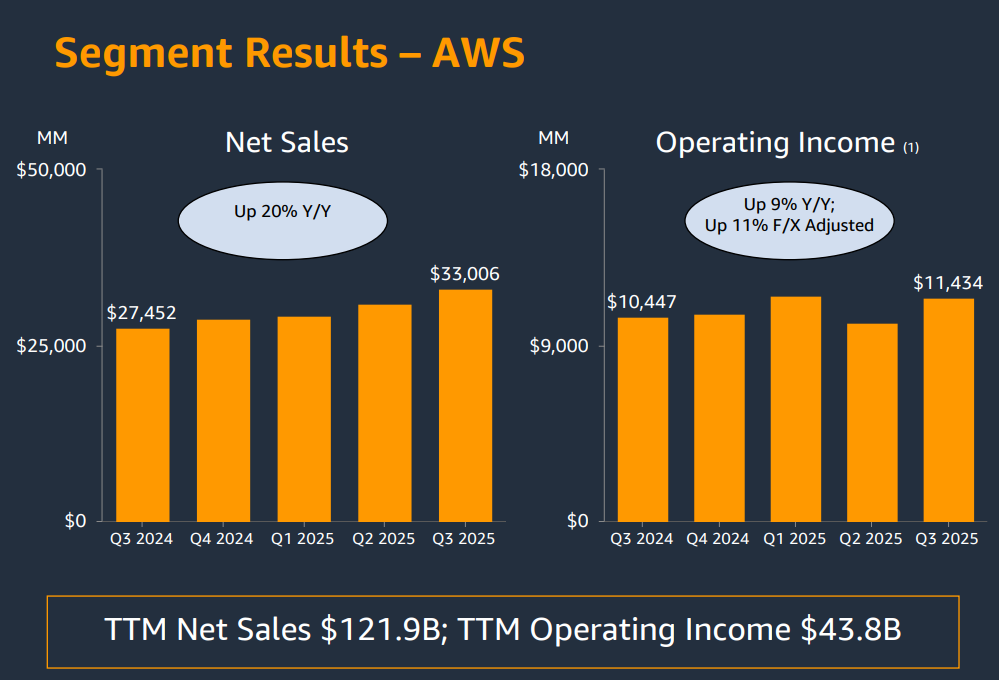
El impulso viene del auge en AI workloads y de una agresiva inversión en capacidad:
Amazon añadió 3.8 GW de potencia en los últimos 12 meses, duplicando su capacidad desde 2022 y planeando duplicar de nuevo para 2027.
Amazon añadió 3.8 GW de potencia en los últimos 12 meses, duplicando su capacidad desde 2022 y planeando duplicar de nuevo para 2027.
“As fast as we’re adding capacity right now, we are monetizing it.” — Jassy
Trainium, el as bajo la manga
Amazon está construyendo su propio ecosistema de chips:
- Trainium2: multibillion-dollar business, +150% QoQ, ya fully subscribed.
- Trainium3: llega en 2026, con +40% de eficiencia.
- Project Rainier: clúster de 500,000 chips Trainium2 (1 M a final de año) donde Anthropic entrena su próximo Claude.
“We’ve recently brought Project Rainier online, our massive AI compute cluster spanning multiple U.S. data centers and containing nearly 500,000 of our Trainium2 chips. Anthoropic is using it now to build and deploy its industry-leading AI model cloud, which we expect to be on more than 1 million Trainium2 chips by year-end. Trainium2 continues to see strong adoption, is fully subscribed is now a multibillion-dollar business that grew 150% quarter-over-quarter.
Today, Trainium is being used by a small number of very large customers but we expect to accommodate more customers starting with Trainium3. We’re building Bedrock to be the biggest inference engine in the world and in the long run, believe Bedrock could be as big a business for AWS as EC2, and the majority of token usage in Amazon Bedrock is already running on Trainium.
We’re also continuing to work closely with chip partners like NVIDIA, with whom we continue to order very significant amounts as well as with AMD and Intel. These are very important partners with whom we expect to keep growing our relationships over time.” — Jassy
AWS quiere que Bedrock (su plataforma de inferencia) sea “tan grande como EC2”, y la mayoría del token usage ya corre sobre Trainium.
La visión de Jassy: AWS como la plataforma de los “agents”
Amazon no solo construye infraestructura, sino las capas base del software generativo:
- AgentCore: infraestructura para desplegar agentes seguros y escalables.
“It’s an enabler… used by Ericsson, Sony, and Cohere Health.”
- Kiro: IDE agentic para developers (+100 k usuarios en días).
Companies will also use other agents, and AWS continues to build many of the agents we believe builders will use in the future.
For coding, we’ve recently opened up our agentic coding IDE called Kiro.
More than 100,000 developers jumped into Kiro in just the first few days of preview and that number has more than doubled since.
It’s processed trillions of tokens thus far, weekly actives are growing fast, and developers love its unique spec and tool calling capabilities.
- Transform: agente para migraciones, ahorrando 335 developer-years en 2025.
- Quick Suite: AI para empresas, reduciendo tiempos de proyectos en 80-90%.
El nuevo mantra: AWS será la plataforma donde vivan los agentes corporativos.
Retail: de Prime Day a leche + electrónica en una sola entrega
“And we started with a few markets about a year ago, and we were really taken aback at the adoption, not just the number of people that started buying perishables from us very quickly, but how often they came back downstream to buy perishables and groceries from us in the future.
And so we’ve now expanded that to 1,000 cities around the U.S. and will be in 2,300 by the end of the year. And it’s really changing the trajectory and the size of our grocery business.” — Jassy
La división de tiendas crece 11% YoY en Norteamérica y está ejecutando su visión omnicanal:
- Perishables same-day delivery ya disponible en 1,000 ciudades (2,300 para fin de año).
- Nuevo botón “Add to delivery” usado 80 M veces desde su lanzamiento.
- Rufus, el asistente AI de compras, ya tiene 250 M usuarios y genera $10 B en ventas incrementales.
- Fresh groceries cambian el comportamiento: los usuarios vuelven el doble de veces.
“This is a game changer for customers who can now order milk alongside electronics, check out with one cart and have everything delivered to their doorstep within hours.” — Jassy
Advertising: el negocio oculto de Amazon sigue despegando
“Shifting to advertising. Advertising revenue was $17.7 billion and growth accelerated for the third consecutive quarter.
We continue to see strong growth on an increasingly large base, as our full funnel advertising approach of connecting brands with customers is resonating.” — Brian Olsavsky, CFO
La división publicitaria, ahora más grande que YouTube Ads en 2018, se beneficia de:
- Expansión de DSP partnerships con Roku, Netflix, Spotify y SiriusXM.
- AI creative tools que generan campañas “en horas en lugar de semanas”.
- Prime Video Live Sports (NBA, Masters 2026, PGA Tour) como nuevo imán publicitario.
“Every single one of our advertising offerings this quarter grew in a meaningful way. I think there’s a few things going on for us.
We have what I think of as a pretty unusual full funnel offering. And if you look at the top of the funnel, which typically tends to be awareness building and broad scale to be able to use our own Prime Video and our live sports capabilities as well as going all the way down to the bottom of the funnel at point of sale being able to use sponsored products, that’s -- most people don’t have a full funnel offering as robust as that.
And then when you layer on top of it, the combination of the audience curation and development we can do, along with the advantage measurement, it just all leads to a return on advertising spend is very unusual.” — Jassy
Robótica, headcount y cultura
“We have over 1 million robots in our fulfillment network at this point. And I would say that while that’s significant, we have a lot of invention in flight.
So I expect that we’ll have more over a period of time. Robotics are very important for us and for our customers and for our teammates because they improve safety, they boost productivity, they increase speed, and they let our human teammates focused on problem solving and what they do best.” — Jassy
La automatización avanza a toda velocidad, pero Jassy remarca la filosofía cultural:
“We are committed to operating like the world’s largest start-up… it means removing layers, increasing ownership, and moving fast.”
CapEx y balance
CapEx acumulado 2025: $89.9 B, con previsión de $125 B para el año completo.
La mayoría va a AWS infra y silicon personalizado, pero también a logística y entregas rurales.
La mayoría va a AWS infra y silicon personalizado, pero también a logística y entregas rurales.
“Looking ahead, we expect our full year cash CapEx to be approximately $125 billion in 2025, and we expect that amount will increase in 2026..
We’ll continue to make significant investments, especially in AI, as we believe it to be a massive opportunity with strong ROIC.” — Olsavsky
El beneficio neto ($21.2 B) incluye una ganancia extraordinaria de $9.5 B por la inversión en Anthropic.

Lectura final
Amazon está entrando en una nueva fase de expansión sincronizada:
- AWS vuelve a crecer con fuerza y tiene “pricing power” vía Trainium.
- Retail reacciona con AI y logística unificada.
- Ads se convierte en el motor de márgenes.
- Y todo apunta a que Q4 y 2026 serán años de CapEx récord, pero con fuerte monetización.
O como lo resumió Jassy:
“You’re going to see us continue to be very aggressive in investing in capacity because we see the demand.
As fast as we’re adding capacity right now, we’re monetizing it. It’s still quite early and represents an unusual opportunity for customers in AWS.”
Lo que vimos en estas conferencias no son simples resultados trimestrales.
Son los planos del nuevo mundo que se está construyendo delante de nosotros.
Si este post te ha aportado algo, te agradezco mucho tu “me gusta” y que lo compartas, es la mejor forma de apoyar este tipo de contenido.
Estamos entrando en una década donde la inteligencia se convierte en el nuevo factor productivo, y quienes sepan entender su dirección no solo invertirán mejor, sino que comprenderán mejor el mundo que viene.
Hasta la próxima,
David.
- Canal de Telegram: https://t.me/tusfinanzaspersonalesybolsa
- Canal de YouTube: https://www.youtube.com/@tusfinanzas_personales
- X (Twitter): https://x.com/Finanzasybolsa
- Instagram👉: tusfinanzaspersonales
